Khalistani Extremists Attack on Hindus
Durgiana Mandir is one of the oldest temples of Amritsar. According to the regional Hindu tradition, the temple was built on the spot where Lava and Kusha bound Hanuman. The temple annually attracts millions of Hindus from all over the country. Amritsar has a very ancient Hindu history. According to the regional Hindu tradition recorded in the “Survey of Amritsar”, Amritsar got its name from Amrit immersed by Lava and Kusha in a pond. Durgiana Mandir was rebuilt in 1921. It was used to house the Murtis of Vishnu and Durga which were thrown out from the Parikrama of Harmandir Sahib in 1905. Because of its presence in Amritsar, it became a frequent target of radicals during the Khalistan movement. In 1982, in what was a completely unprovoked attack, the Dal Khalsa “activists” threw a severed cow head inside the Durgiana temple.
Mahakali temple of Patiala is a very famous temple. It was built by Maharaja Bhupinder Singh of Patiala. The Murti of Kali was brought from Bengal. In 1982, Khalistani radicals hung the tail of a cow inside the Mahakali temple of Patiala. Devotees were shocked to see the tail of a cow hung inside the Garba Griha of the temple.
Dal Khalsa, an organization that claims that it strives to establish an independent Khalsa state, not only took responsibility for these attacks but also declared their intention of repeating them.
Ram Tirath is one of the oldest temples of Amritsar. According to the Hindu tradition, Ram Tirath was the place where Goddess Sita gave birth to Lava and Kusha. On December 3, 1983, Khalistani activists sprinkled petrol on the Murtis of Krishna, Subhadra, and Balrama inside the Garba Girha of Ram Tirath temple and set the Murtis on fire. It is to be noted that all these incidents happened prior to Operation Blue Star carried out by Congress Government in 1984.
The attacks of Hindu temples were not confined to just Punjab. The radicals crossed over Punjab into Haryana and bombed Hindu temples. Panchmukhi Hanuman Mandir is a very famous temple of Haryana. Coins of ancient Yaudheyas dating back to 100 BC have been found at this ancient temple. On November 21 1983, two bombs were thrown on this temple. A damaged section was later rebuilt by funds collected from devotees.
Even the Jain temples were not spared. On May 5, 1984, the Jain temple in Amritsar was looted and desecrated. Because the Jains are a very affluent community, Jain temples were seen by radicals as a great source for loot. On February 28 of the same year, another Jain temple was looted.
While Jain temples were a great source for loot, Hindu processions typically had a large congregation. They bombed Hindu fairs like Shivaratri & Ramnavami where Hindus gathered in large numbers to ensure maximum Hindu killings. Shivala Temple of Amritsar was bombed on Shivaratri.
- Sep 9, 1981: Lala Jagat Narain, founder of Punjab Kesri and MP from Punjab was killed by Khalistanis
- 26 April 1982: Two cow heads were placed at the gates of two Hindu temples in Amritsar. One of the temples was Durgiana Mandir.
- 29 April 1982: Mahakali temple of Patiala is a very famous temple. It was built by Maharaja Bhupinder Singh of Patiala. The Murti of Kali was brought from Bengal. Khalistani radicals hung the tail of a cow inside the Mahakali temple of Patiala. Devotees were shocked to see the tail of a cow hung inside the Garba Griha of the temple. [citation?]
- During the Shivala temple bombing on February 29, 1984, 3 people were killed and 32 injured. The damaged section of the temple could not be rebuilt until 2005.
- June 25, 1983: a Pujari of a temple in Sultanpur was killed with a sharp knife. Brahmins were a favorite target of Khalistani activists. Bhindranwale’s rhetoric frequently centered on anti-Brahmanism.
- Nov 21, 1983: Panchmukhi Hanuman Mandir is a very famous temple of Haryana. Coins of ancient Yaudheyas dating back to 100 BC have been found at this ancient temple. Two bombs were thrown on this temple. A damaged section was later rebuilt by funds collected from devotees. [citation?]
- Dec 3, 1983: Ram Tirath is one of the oldest temples of Amritsar. According to the Hindu tradition, Ram Tirath was the place where Goddess Sita gave birth to Lava and Kusha. On December 3, 1983, Khalistani activists sprinkled petrol on the Murtis of Krishna, Subhadra, and Balrama inside the Garba Girha of Ram Tirath temple and set the Murtis on fire.
- Feb 1, 1984: Mukuts of silver weighing 1 Kg were stolen from Madan Mohan Mandir, Tarn Taran in Punjab.
- Feb 21, 1984: Three temples were damaged at Bathinda
- April 8, 1984: Bomb exploded in the courtyard of Santoshi Mata temple, killing the home guard and chowkidar. The Santhoshi Mata temple had been a recently constructed temple of Punjab. A recently constructed Hindu temple was seen by radicals as an affront to them.
- May 31, 1988: Khalistani radicals bombed Shivala Hindu temple and a market, killing 28 and injuring 100. This was the second attack on the temple in 4 years.
- In the 1980s and 1990s, not everybody in Punjab had television sets. People used to gather outside shops to watch the serial Mahabharata based on the great Hindu epic. The Khalistani radicals used to bomb such gatherings.
- Like Mahabharata, the great epic Ramayana was also the target of these radicals. In 1988, Kurukshetra (Haryana), people watching Ramayana in public were bombed by Khalistan radicals.
- May 30, 1988: 28 people killed and 100 injured in a bomb blast outside Shivala Temple in Amritsar
- Nov 11, 1989: Sikh separatists killed 19 Hindu students in Thapar
1991: Khalistani terrorists claim responsibility for the bomb attack that killed 40 Hindus attending Ram Lila celebrations
- Giani Partap Singh was a former jathedar of the Akal takht. He was over 80 years old and highly respected. He opposed Bhindrewale’s collecting tons of weapons inside the GT. Bhindrewale’e men shot him dead at his home.
- Niranjan Singh - the Granthi of Gurudwara Toot Sahib
- Granthi Surat Singh of Majauli
- Granthi Jarnail Singh of Valtoha
- Once Bhindranwale occupied the Akal Takht, he turned it into a charnel house of torture and butchery. In one highly publicized case, when one of Bhindranwale’s favoured hitmen, Surinder Singh Sodhi was killed in a fracas with some of the other criminals in his entourage, brutal retaliation followed. One of the conspirators, Malik Singh Bhatia, was summoned to the Akal Takht, and after a charade of ‘forgiveness’, was first hacked with swords and, grievously wounded, when he tried to flee, shot down on the Parikrama. Baljit Kaur, a woman conspirator, was tortured, her breasts hacked off, and then killed within the Akal Takht itself.
- M.L. Manchanda was beheaded for broadcasting in Punjabi and Hindi instead of just broadcasting in Punjabi.
- Punjab Police DIG A S Atwal murdered while visiting Golden Temple
Casualties inflicted by Khalistanis decreased from 1518 civilians in 1992 to a mere 28 civilians in 1993. Terrorism was suppressed by 1992 in terms of its effectiveness to inflict casualties on civilians.
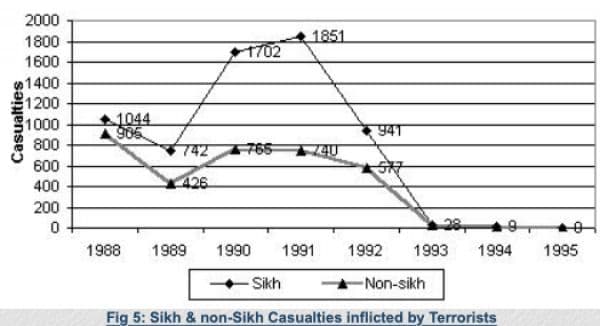
Along with the deployment of army troops in Punjab, the strength of the Punjab civil police force was doubled to 65,000 in 1993 from 32,000 in 1983.
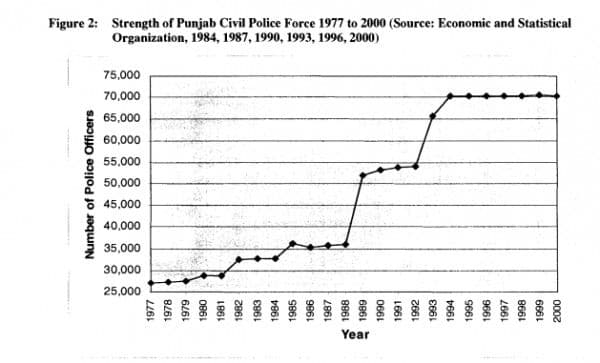
Hand Guns recovered in Punjab: It shows a significant number of handguns were seized from 1988 until 1993. After 1993, it can very clearly be seen that the number of illegal handguns seized has come down, indicating that the strength of terr0r organizations weakened by 1993.
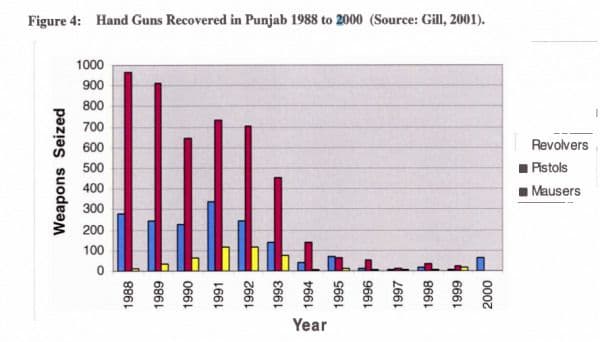
Explosives and b0mbs recovered in Punjab: 2750 kgs of illegal explosives were recovered in Punjab in 1993 as opposed to just 60 kgs of explosives in 1994. This again shows that by 1992-1993, terrorism began to be greatly weakened in Punjab. Again, hardly anything in 1994-1995.
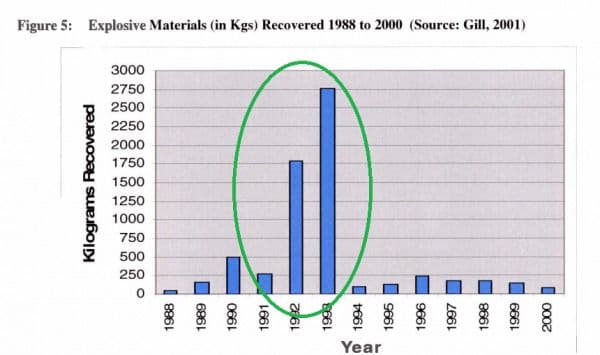
Terrorists killed in Punjab: Most of the killings of terr0rists took place in 1988-1993. One can see the sharp decline in the number of terr0rists killed in 1994-1995 because there were hardly any left to be killed. The counter terr0r operation eliminated most terr0rists by 1992-93.
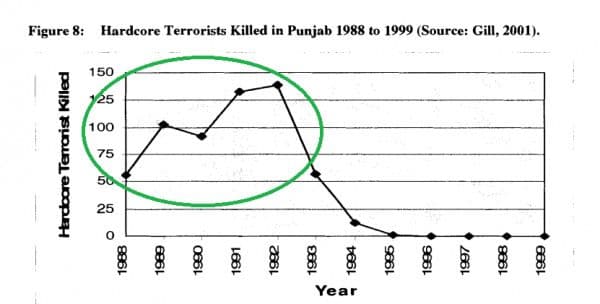
To summarize:
- Data tells us that by 1992, civilian casualties inflicted by terrorists sharply decreased.
- Guns and bombs were seized at record levels in 1992-93, the terrorists became toothless.
- Terrorists were eliminated at record levels.
From early to mid-1993 onwards, there was hardly any ground-level terrorism in Punjab. Most of the terr0rists either surrendered, gave up their professions, or went into exile. Some escaped from India. The official statisticians say that the terrorist movement collapsed by 1993.
Source:
- https://twitter.com/BharadwajSpeaks/status/1354082801096777730
- https://twitter.com/AkkaPrasanna/status/1402272424079597568
- https://twitter.com/BharadwajSpeaks/status/1461933538530394118
- https://www.hinduamerican.org/issues/land-of-pure-khalistan
- https://en.wikipedia.org/wiki/List_of_terrorist_incidents_in_Punjab,_India
- White paper on Punjab Agitation